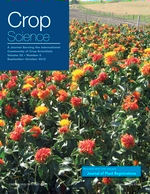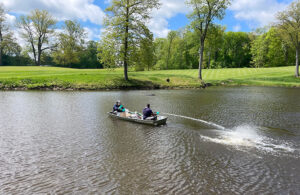Study: Athletic field paint steals spotlight from the grass it covers
 MADISON, WI — Professional athletic field managers maintain trimmed turfgrass with great precision, carefully painting crisp lines and colorful logos on their grass before each game. While these fields appear to be in perfect health, some field managers have noted deteriorating turfgrass beneath repeated paint applications.
MADISON, WI — Professional athletic field managers maintain trimmed turfgrass with great precision, carefully painting crisp lines and colorful logos on their grass before each game. While these fields appear to be in perfect health, some field managers have noted deteriorating turfgrass beneath repeated paint applications.
New research now suggests why. In a study that appears in the September-October issue of Crop Science, three North Carolina State University researchers found that grasses coated with latex paints show a notable reduction in photosynthesis.
In their study, which was funded by the Center for Turfgrass Research and Environmental Education at NC State University, the researchers prepared 60 pots with sand and peat substrate before seeding each with perennial ryegrass, a grass commonly used on professional football and baseball fields including most NFL and MLB fields. After the grass matured, two different dilutions (no-dilution, and 1:1 dilution with water) of red and white latex paints were applied to the turf samples weekly for six weeks.
To recognize how paint affects turfgrass health, it’s important to first understand how paint itself functions. Latex paints consist of four different components: resins, solvents, additives, and pigments. Each has a unique role in the painting process.
Resins act like an adhesive, allowing paint to stick to surfaces. Solvents dilute the paint and help ensure a consistent application thickness. Additives help distribute the pigments, the fourth component, into the liquid paint. Of these ingredients, the scientists say pigments pose the biggest threat to turfgrass.
Pigments are used in paint to ensure a surface is completely coated, and give paint its color by absorbing specific wavelengths of light while reflecting others. This wavelength-selective absorption allows for the wide variety of paint colors that exist today.
However, the NC State researchers suspected the coating of pigment on turfgrass was also damaging the grass by shielding it from the sun and reducing photosynthetically active radiation (PAR). PAR consists of wavelengths of light in the 400 to 700 nm range that plants use in photosynthesis.
The researchers looked at the reflection, transmission, and absorption of PAR in the four different paints, determining that red paint absorbs the highest amounts of PAR. By observing the carbon exchange rates in the painted turfgrass samples, the team also found red paint was more damaging to total canopy photosynthesis (TCP) than white paint, although diluting each color with water reduces their negative effects.
Results from this study further suggest that white paint reflects more PAR in the turfgrass canopy, allowing it to be absorbed by plants for photosynthesis. Over the course of the six-week study, diluted white paint reduced TCP by only 19%. However, the absorption of PAR by red paint eliminates the benefits of PAR reflection by the white and reduces TCP more drastically, the effects worsening as paint applications increase. The no-dilution red paint produced a 75% reduction in TCP by the final application.
The results from this study confirmed pigment’s crucial role in the availability of PAR for plant use underneath latex paint. But more research is needed to fully explore the impacts different types of athletic field paint have on turfgrass photosynthesis and growth, say the scientists.
In a global sports market where field paint application plays a crucial role in the industry, understanding the delicate relationship between latex paints and grass will not only help improve turfgrass health but may also change the properties of paint products themselves.
The full article is available for no charge until Sept. 27, 2012. View the abstract at https://www.crops.org/










